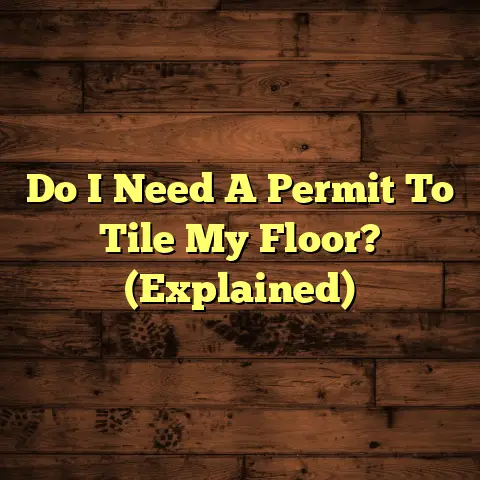Vintage Checkerboard Tile Look (2 Style Secrets!)
“When I walked into my kitchen after the remodel, I felt like I had stepped back in time. The vintage checkerboard tiles brought a charm and character that I never knew my home was missing.” – Sarah, a delighted homeowner from Portland.
That quote from Sarah perfectly captures the magic of vintage checkerboard tile. As a flooring contractor for over 20 years, I’ve seen firsthand how this classic design can transform a space. Want to know my secrets? Let’s dive in!
Section 1: The Allure of Vintage Checkerboard Tiles
Historical Context: More Than Just Squares
Checkerboard tile isn’t just a pattern; it’s a piece of history. Its roots trace back centuries, but it really hit its stride during the Art Deco era of the 1920s and then again in the mid-century modern boom of the 1950s.
Think of those classic diners and soda fountains – checkerboard tile was practically a requirement!
Back then, materials like ceramic and marble were the go-to choices. These materials offered durability and a timeless elegance that contributed to the pattern’s enduring appeal.
I’ve even salvaged original marble checkerboard floors from homes built in the early 1900s! The craftsmanship is incredible and the history, tangible.
Versatile Applications: Not Just for Kitchens!
Don’t limit checkerboard to just the kitchen floor! I’ve seen it work wonders in:
-
Bathrooms: Creates a clean, classic look.
-
Entryways: Makes a bold first impression.
-
Patios: Adds a touch of retro charm to outdoor spaces.
-
Laundry Rooms: Brightens up a utilitarian space.
It’s all about how you incorporate it into your overall design.
I once helped a client create a stunning checkerboard patio using weather-resistant porcelain tiles. It completely transformed their backyard!
Section 2: Style Secret 1 – Color Combinations: Beyond Black and White
Classic Black and White: Timeless for a Reason
Let’s be honest, black and white checkerboard is iconic. It’s a high-contrast, visually striking pattern that works in almost any setting.
Why? Because it’s simple, elegant, and creates a sense of order. It’s a safe bet, but it’s also a stylish bet.
I’ve installed countless black and white checkerboard floors, and each one brings a unique energy to the room.
Think about it – a black and white checkerboard floor paired with red accents in a kitchen? Chef’s kiss!
Bold and Unexpected Colors: Express Yourself!
Who says checkerboard has to be black and white? Let’s break the rules!
I’m talking navy and white, red and cream, even green and black. The possibilities are endless!
Here’s my advice for choosing bold colors:
-
Consider your wall color: Choose complementary colors that won’t clash.
-
Think about your decor: Make sure your furniture and accessories work with the tile colors.
-
Don’t be afraid to experiment: Order samples and see what looks best in your space.
I once convinced a client to go with a teal and white checkerboard in their bathroom. It was a risk, but it paid off big time! It was featured in a local design magazine.
Here’s a table showcasing some trendy and unique color combinations:
| Color Combination | Style | Best Used In |
|---|---|---|
| Navy and White | Coastal, Classic | Bathrooms, Entryways |
| Red and Cream | Retro, Vintage | Kitchens, Laundry Rooms |
| Green and Black | Eclectic, Modern | Living Rooms, Offices |
| Gray and Yellow | Contemporary | Any Room |
| Pink and White | Feminine, Chic | Bedrooms, Bathrooms |
Section 3: Style Secret 2 – Layout and Pattern Play: It’s All About the Arrangement
Traditional Layouts: The Grid is Your Friend
The classic checkerboard layout is a simple grid. Each tile is the same size, and they’re arranged in alternating colors.
It’s straightforward, but it creates a sense of order and symmetry. This is the layout you typically see in vintage diners and classic kitchens.
The key to a traditional look is consistent tile size and spacing. Uneven tiles or grout lines will throw off the whole effect.
I always emphasize the importance of precise measurements and careful installation when working with a traditional checkerboard layout.
Creative Layouts: Twist the Rules!
Want to add a modern twist to a classic pattern? Try these alternative layouts:
-
Diagonal Checkerboard: Rotate the grid 45 degrees for a more dynamic look.
-
Mixed Tile Sizes: Use different sized tiles to create a more random, textured pattern.
-
Bordered Checkerboard: Add a solid border around the checkerboard field for a more defined look.
Experiment with different layouts to see what works best in your space. Don’t be afraid to get creative!
I once designed a diagonal checkerboard floor using three different shades of gray. It was a subtle but striking variation on the classic pattern.
Here are some of the creative layouts you can consider:
| Layout | Description | Visual Impact |
|---|---|---|
| Diagonal | Tiles are laid out on a 45-degree angle, creating a diamond pattern instead of squares. | Dynamic, Spacious |
| Offset/Staggered | Tiles are offset, similar to a brick pattern, to create a more casual, less rigid look. | Relaxed, Rustic |
| Large Format Checker | Use larger tile sizes for a more modern and expansive feel. | Modern, Minimalist |
| Multi-Size Checker | Incorporate multiple tile sizes within the checkerboard pattern for added visual interest. | Playful, Eclectic |
| Bordered Checker | Add a solid or decorative border around the checkerboard field to define the space and add a polished finish. | Elegant, Well-Defined |
Section 4: Maintenance and Care for Vintage Checkerboard Tiles: Keeping It Fresh
Cleaning Techniques: Gentle is Key
Vintage tiles, especially marble, require special care. Harsh chemicals can damage the surface and dull the finish.
Here’s my go-to cleaning routine:
-
Sweep or vacuum regularly: Remove loose dirt and debris.
-
Mop with a pH-neutral cleaner: Avoid acidic or alkaline cleaners.
-
Use a soft cloth or mop: Don’t use abrasive scrubbers.
-
Dry the floor thoroughly: Prevent water spots and stains.
I always recommend testing any new cleaning product in an inconspicuous area first. Better safe than sorry!
Repairing and Restoring: When to Call a Pro
Cracks and chips are inevitable, especially in older homes. Here’s what you need to know about repairing and restoring vintage checkerboard tile:
-
Small chips: Can often be filled with epoxy or color-matched filler.
-
Cracks: May require replacing the entire tile.
-
Stains: Try a poultice made of baking soda and water.
When to call a pro? If you’re dealing with extensive damage, or if you’re not comfortable working with delicate materials, it’s best to hire a professional.
I’ve seen DIY repairs go wrong more times than I can count. Sometimes it’s worth paying for the peace of mind!
Here’s a table to guide you on when to DIY or call a pro:
| Issue | DIY Feasibility | When to Call a Professional |
|---|---|---|
| Small Chips | High (using epoxy or color-matched filler) | Large or numerous chips, especially on marble |
| Minor Cracks | Medium (with crack repair kits) | Significant cracks that affect structural integrity or multiple tiles |
| Stains | Medium (using poultices) | Deep-set stains or discoloration that doesn’t respond to basic cleaning |
| Loose Tiles | Low | Most cases, as it often indicates underlying issues like subfloor damage or improper installation |
| Grout Issues | Medium (re-grouting small areas) | Extensive grout damage or if you’re uncomfortable with the process |
| Extensive Tile Damage | Low | Any significant damage that requires tile replacement or restoration |
| Restoration | Very Low (requires specialized knowledge) | To ensure the tiles are properly cleaned, repaired, and sealed without causing further damage |
Conclusion: Your Turn to Create a Timeless Space
Vintage checkerboard tile is more than just a trend; it’s a timeless design element that can add character and charm to any home. By understanding the history, exploring different color combinations and layouts, and properly maintaining your tiles, you can create a space that’s both stylish and enduring.
“The checkerboard floor is the first thing people notice when they walk into my house. It’s a conversation starter, and it makes me smile every time I see it.” – Mark, homeowner from Chicago.
So, what are you waiting for? It’s your turn to transform your space with the magic of vintage checkerboard tile!




